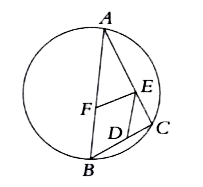In the parallelogram ABCD, ¯¯¯¯¯¯AD2−¯¯¯¯¯¯AB2 =
4¯¯¯¯¯¯AB. (orthogonal projection of ¯¯¯¯¯¯AD on ¯¯¯¯¯¯AB)
2¯¯¯¯¯¯AB. (orthogonal projection of ¯¯¯¯¯¯AD on ¯¯¯¯¯¯AB)
¯¯¯¯¯¯AC. (orthogonal projection of ¯¯¯¯¯¯BD on ¯¯¯¯¯¯AC)
2¯¯¯¯¯¯AC. (orthogonal projection of ¯¯¯¯¯¯BD on ¯¯¯¯¯¯AC)
The correct Answer is:C
Topper's Solved these Questions
- PRODUCTS OF VECTORSBook:DIPTI PUBLICATION ( AP EAMET)Chapter:PRODUCTS OF VECTORSExercise:Exercise 1B Cross Product of Vectors
Explore 73 Videos
- PRODUCTS OF VECTORSBook:DIPTI PUBLICATION ( AP EAMET)Chapter:PRODUCTS OF VECTORSExercise:Exercise 1C (Triple product of Vectors
Explore 112 Videos
- PRODUCTS OF VECTORSBook:DIPTI PUBLICATION ( AP EAMET)Chapter:PRODUCTS OF VECTORSExercise:Exercise 2 (Special Type Questions) SET -D
Explore 14 Videos
- PROBABILITYBook:DIPTI PUBLICATION ( AP EAMET)Chapter:PROBABILITYExercise:EXERCISE 2 (SPECIAL TYPE QUESTIONS) SET-4
Explore 5 Videos
- PROPERTIES OF TRIANGLES Book:DIPTI PUBLICATION ( AP EAMET)Chapter:PROPERTIES OF TRIANGLES Exercise:EXERCISE 2 (SPECIAL TYPE QUESTIONS) Set-4
Explore 10 Videos
Similar Questions
Knowledge Check
In parallelogram ABCD, if ¯¯¯¯¯¯AB=¯aand¯¯¯¯¯¯AD=¯b, then the diagonals interm of ¯aand¯b are
A¯a+¯b,¯a−¯bB¯a,¯bC¯a+¯b,¯b−¯aD2¯a,2¯bIf ¯¯¯¯¯¯AC=3ˆi+ˆj−2ˆk,¯¯¯¯¯¯DB=ˆi−3ˆj−4ˆk are the vectors along the diagonals of a parallelogram ABCD and ¯¯¯¯¯¯AE=ˆi+2ˆj+3ˆk is another vector, then the volume of the paralleloP1ped whose co-terminous edges are represented by the vectors ¯¯¯¯¯¯AB,¯¯¯¯¯¯AD,¯¯¯¯¯¯AE is
A2cu. UnitsB10cu. UnitsC6cu. UnitsD12cu. UnitsIn quadrilateral ABCD, if ¯¯¯¯¯¯AB=¯¯¯¯¯¯CD, then it is
AtrapeziumBparallelogramCkiteDrhombus
If the points A(¯a),B(¯b),C(¯c) are collinear and 3¯a+2¯b−5¯c=¯0, then
View SolutionIf the points A(¯a),B(¯b),C(¯c) are collinear and 2¯a+3¯b−5¯c=¯0, then
View SolutionIn the figure given below , ¯¯¯¯¯¯ED∣∣∣∣¯¯¯¯¯¯ABand¯¯¯¯¯¯EF∣∣∣∣¯¯¯¯¯¯BC. If ∠FED=40∘and∠DEC=20∘ , then the angle made by ¯¯¯¯¯¯BC at the centre is _______.

View SolutionIf ¯a,¯band¯c are unit vectors perpendicular to each other, the [¯a¯b¯c]2=
View SolutionABCDE is a pentagon. The resultant of the vectors ¯¯¯¯¯¯AB,¯¯¯¯¯¯AE,¯¯¯¯¯¯BC,¯¯¯¯¯¯DC,¯¯¯¯¯¯EDand¯¯¯¯¯¯AC in terms of ¯¯¯¯¯¯AC is
View Solution

